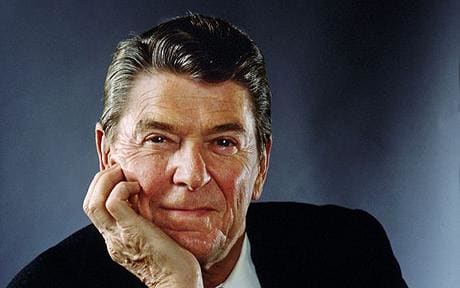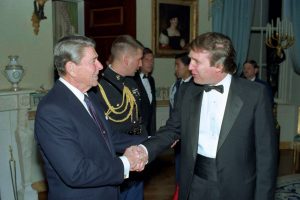
Ronald Wilson Reagan (February 6, 1911)
The life cycle 124875
Important years of life
1919 2
1921 4
1925 8
1933 7
1940 5
1945 1
1946 2
1948 4
1952 8
1960 7
1967 5
1972 1
1973 2
1975 4
1979 8
1987 7
1994 5
1999 1
2000 2
2002 4
continue the life cycle
2006 8
2014 7
2021 5
2026 1
********* wiki information
Reagan’s father nicknamed his son “Dutch”, due to his “fat little Dutchman”-like appearance and “Dutchboy” haircut; the nickname stuck with him throughout his youth. Reagan’s family briefly lived in several towns and cities in Illinois, including Monmouth, Galesburg, and Chicago. In 1919, they returned to Tampico and lived above the H. C. Pitney Variety Store until finally settling in Dixon.
Before the film Santa Fe Trail with Errol Flynn in 1940, he played the role of George “The Gipper” Gipp in the film Knute Rockne, All American; from it, he acquired the lifelong nickname “the Gipper.”
In 1938, Reagan co-starred in the film Brother Rat with actress Jane Wyman (1917–2007). They announced their engagement at the Chicago Theatre and married on January 26, 1940 at the Wee Kirk o’ the Heather church in Glendale, California. Together they had two biological children, Maureen (January 4, 1941 – August 8, 2001) and Christine (b. in 1947 but lived only one day), and adopted a third, Michael (b. 1945). After the couple had arguments about Reagan’s political ambitions, Wyman filed for divorce in 1948, citing a distraction due to her husband’s Screen Actors Guild union duties; the divorce was finalized in 1949
He was recommended for promotion to major on February 2, 1945, but this recommendation was disapproved on July 17 of that year. While with the First Motion Picture Unit in 1945, he was indirectly involved in discovering actress Marilyn Monroe. He returned to Fort MacArthur, California, where he was separated from active duty on December 9, 1945
At rallies, Reagan spoke frequently with a strong ideological dimension. In December 1945, he was stopped from leading an anti-nuclear rally in Hollywood by pressure from the Warner Bros. studio. He would later make nuclear weapons a key point of his presidency when he specifically stated his opposition to mutual assured destruction. Reagan also built on previous efforts to limit the spread of nuclear weapons Reagan was first elected to the Board of Directors of the Screen Actors Guild (SAG) in 1941, serving as an alternate member. After World War II, he resumed service and became third vice-president in 1946.
In the 1948 presidential election, Reagan strongly supported Harry S. Truman and appeared on stage with him during a campaign speech in Los Angeles. In the early 1950s, his relationship with actress Nancy Davis grew, and he shifted to the right when he endorsed the presidential candidacies of Dwight D.
Eisenhower (1952 and 1956) and Richard Nixon (1960).
Reagan met actress Nancy Davis (1921–2016) in 1949 after she contacted him in his capacity as president of the Screen Actors Guild. He helped her with issues regarding her name appearing on a Communist blacklist in Hollywood. She had been mistaken for another Nancy Davis. She described their meeting by saying, “I don’t know if it was exactly love at first sight, but it was pretty close. They were engaged at Chasen’s restaurant in Los Angeles and were married on March 4, 1952, at the Little Brown Church in the Valley (North Hollywood, now Studio City) San Fernando Valley. Actor William Holden
served as best man at the ceremony. They had two children: Patti (b. 1952) and Ronald “Ron” Jr. (b. 1958).
Prior to the presidency, he was a Hollywood actor and union leader before serving as the 33rd Governor of California from 1967 to 1975.
His efforts to enforce the state’s laws in this area were thwarted when the Supreme Court of California issued its People v. Anderson decision, which invalidated all death sentences issued in California before 1972, though the decision was later overturned by a constitutional amendment. The only execution during Reagan’s governorship was on April 12, 1967, when Aaron Mitchell’s sentence was carried out by the state in San Quentin’s gas chamber.
He reappointed Paul Volcker as Chairman of the Federal Reserve, and in 1987 he appointed monetarist Alan Greenspan to succeed him. Reagan ended the price controls on domestic oil that had contributed to the energy crises of 1973–74 and the summer of 1979
After the funeral, the Reagan entourage was flown back to the Ronald W. Reagan Presidential Library in Simi Valley, California, where another service was held, and President Reagan was interred. At the time of his death, Reagan was the longest-lived president in U.S. history, having lived 93 years and 120 days (2 years, 8 months, and 23 days longer than John Adams, whose record he surpassed). He was the first U.S. president to die in the 21st century, and his was the first state funeral in the United States since that of President Lyndon B. Johnson in 1973.
Reagan escalated the Cold War, which accelerated a reversal from the policy of détente that began in 1979 after the Soviet war in Afghanistan
On October 25, 1983, Reagan ordered U.S. forces to invade Grenada (codenamed “Operation Urgent Fury”) where a 1979 coup d’état had established an independent non-aligned Marxist–Leninist government. A formal appeal from the Organisation of Eastern Caribbean States (OECS) led to the intervention of U.S. forces; President Reagan also cited an allegedly regional threat posed by a Soviet-Cuban military build-up in the Caribbean and concern for the safety of several hundred American medical students at St. George’s University as adequate reasons to invade. Operation Urgent Fury was the first major military operation conducted by U.S. forces since the Vietnam War, several days of fighting commenced, resulting in a U.S. victory, with 19 American fatalities and 116 wounded American soldiers. In mid-December, after a new government was appointed by the governor-general, U.S. forces withdrew
In 1987 Reagan renewed his call for Congress to support voluntary prayer in schools and end “the expulsion of God from America’s classrooms.”

President Reagan with real estate developer and future president Donald Trump in 1987
The administration’s stance toward the savings and loan industry contributed to the savings and loan crisis. A minority of the critics of Reaganomics also suggested that the policies partially influenced the stock market crash of 1987, but there is no consensus regarding a single source for the crash. In order to cover newly spawned federal budget deficits, the United States borrowed heavily both domestically and abroad, raising the national debt from $997 billion to $2.85 trillion. Reagan described the new debt as the “greatest disappointment” of his presidency.
Speaking at the Berlin Wall on June 12, 1987, Reagan challenged Gorbachev to go further, saying “General Secretary Gorbachev, if you seek peace, if you seek prosperity for the Soviet Union and Eastern Europe, if you seek liberalization, come here to this gate! Mr. Gorbachev, open this gate! Mr. Gorbachev, tear down this wall!”
Before Gorbachev’s visit to Washington, D.C., for the third summit in 1987, the Soviet leader announced his intention to pursue significant arms agreements.The timing of the announcement led Western diplomats to contend that Gorbachev was offering major concessions to the United States on the levels of conventional forces, nuclear weapons, and policy in Eastern Europe. He and Reagan signed the Intermediate-Range Nuclear Forces Treaty (INF Treaty) at the White House, which eliminated an entire class of nuclear weapons. The two leaders laid the framework for the Strategic Arms Reduction Treaty, or START I; Reagan insisted that the name of the treaty be changed from Strategic Arms Limitation Talks to Strategic Arms Reduction Talks.
In January 1987, Reagan underwent surgery for an enlarged prostate that caused further worries about his health. No cancerous growths were found and he was not sedated during the operation
Reagan nominated conservative jurist Robert Bork to the high court in 1987.
Reagan disclosed in November 1994 that he had been diagnosed with Alzheimer’s disease earlier that year.
In a letter to the American people in 1994, Reagan wrote “I have recently been told that I am one of the millions of Americans who will be afflicted
with Alzheimer’s disease… I only wish there was some way I could spare Nancy from this painful experience,”
His final public speech was on February 3, 1994, during a tribute to him in Washington, D.C., and his last major public appearance was at the funeral of Richard Nixon on April 27, 1994
He remained active, however; he took walks through parks near his home and on beaches, played golf regularly, and until 1999 he often went to his office in nearby Century City
He was among 18 included in Gallup’s most admired man and woman poll of the 20th century, from a poll conducted in the U.S. in 1999
Congress authorized the creation of the Ronald Reagan Boyhood Home in Dixon, Illinois in 2002, pending federal purchase of the property. On May 16 of that year, Nancy Reagan accepted the Congressional Gold Medal, the highest civilian honor bestowed by Congress, on behalf of the president and herself
Every year from 2002, California governors Gray Davis and Arnold Schwarzenegger proclaimed February 6 “Ronald Reagan Day” in the state of California in honor of their most famous predecessor.
*********
James Scott Brady (August 29, 1940 – August 4, 2014) was an assistant to the U.S. President and White House Press Secretary under President Ronald Reagan.
March 30, 1981 = 2014
August 4, 2014 = 2026